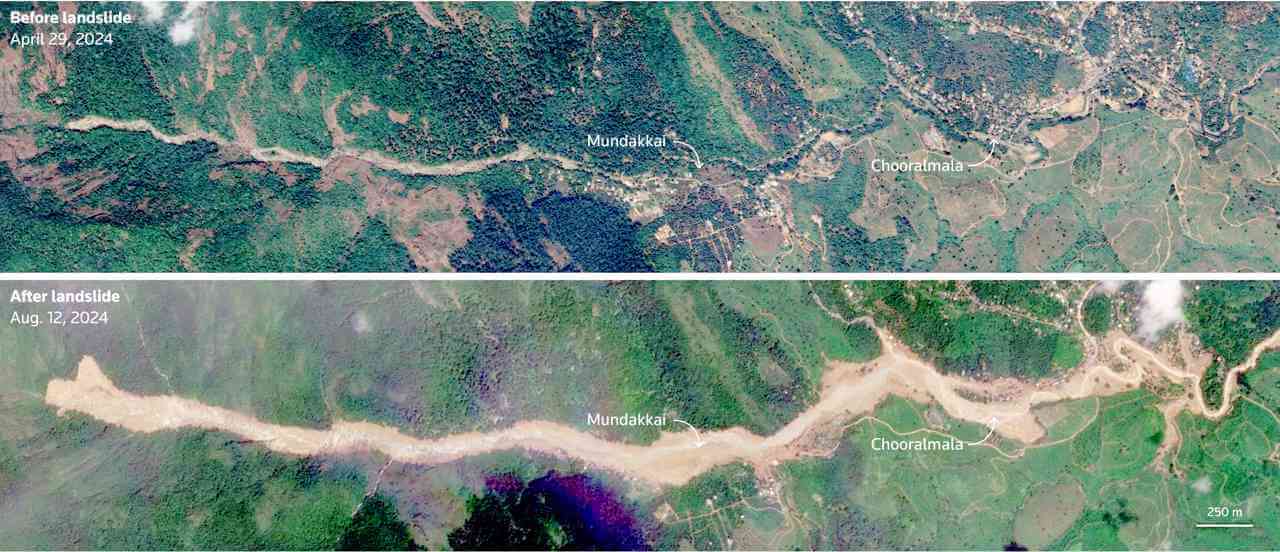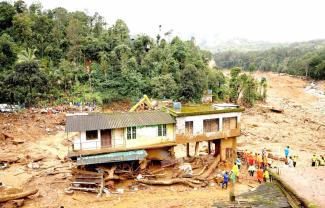Meppadi panchayat of Wayanad district of Kerala was devastated in the wee hours of July 30. Relentless rainfall wrought two event of deadly landslides that resulted in the death of 231 people in their sleep and 128 people still missing; the devastation was so ghastly that many victims were broken into pieces- 205 body parts were recovered. About 400 houses of Mundakkai, Chooralmala and Attamala villages were completely destroyed, many washed off in the torrent of water, mud, boulders and gravel from the upstream epicentre of the landslide.
This tragedy follows the 2018 deluge that affected a large part of the state, wrecking damages estimated at Rs 40000 crores, and the 2019 landslides in Wayanad and Malappuram districts that took 75 lives- the Wayanad site of Puthumalai is barely six kilometers away from Chooramala.
The latest tragedy marked Kerala as a perpetual victim of climate change, in the making of which the state has no significant role. Although some were quick to blame an assumed reduction in forest cover and the presence of stone quarries and even seriously attributing the heavy precipitation to the dust from the quarries, this disaster confirms Kerala as a hapless theatre where the impact of the climate crisis is being played out in succession. The first bout of landslide occurred at 2 am of 30 July and the second - the more devastating - at 5 am. In the preceding 24 hours from the second catastrophe the area was lashed by rainfall measuring a frightening 372 mm. 204.5 mm rain is what qualifies as extremely heavy as per the definition of the India Meteorological Department. And this rain was falling on a landscape that was already soaked by 200 mm rain in the 24 hours prior to that, pounding the area with 572 mm rain in 48 hours prior to the inevitable catastrophe.
Changes in the intensity and distribution of rain as a result of global warming were predicted by the multidisciplinary Intergovernmental Panel on Climate Change (IPCC) in 2007. IPCC reported with high confidence in 2021 that ‘heavy precipitation and associated flooding are to intensify and be more frequent in most regions in Africa and Asia’. When this prediction is being played out in Wayanad, there are interest groups hard at work to divert attention from the debilitating climate crisis. The argument of loss of forest doesn’t hold water as, if the 2021 forest estimation report of the Forest Survey of India can be trusted, Wayanad has 74.2 per cent of the land area under forest cover and a net gain of 0.29 sq km of forest from the preceding two years, and not a loss of forest. There are quarries in Wayanad as elsewhere in the Western Ghats, but the nearest quarry was 10.5 km away from the epicentre of the landslide, which notably is a Reserve Forest area. UAE, as a petroleum exporting country, was shy to attribute the devastating April floods to climate change, but the country was lashed by 254 mm rains in just 24 hours between April 14 and 15, while the total rain recorded for the year of 2022 was only 56.2 mm spread over 10 months.
Some commenters, like Dr Madhav Gadgil and associates, were too quick to jump to blame forest loss and quarries during the 2018 deluge too, totally ignoring the fact that no landscape can bear the torrent of continuous rain from 9 to 15 August of that year which was 257 per cent of the normal rainfall during this period. The FSI report of 2017 had recorded a net increase in forest cover in the state during the reporting period. June used to be a month of good rain in Wayanad but this June the biodiversity rich hill district was rain deficient. As if the moisture was stored for the devastation in the early morning of 30th July, menacing cascade of water and stones literally washed away two villages. Another community of hapless victims of the climate crisis wrought by the industrial countries and the rich of the developing world. Dr Gadgil’s argument this time was so outlandish as to claiming the dust (‘aerosol’, he says) from the stone quarries as the cause for the heavy precipitation, as outlandish as his claim of the caste apartheid as an ideal system for sustainable natural resources management and his new accusation that Dr Salim Ali, the father of India’s conservation movement, was an American agent.
While the genuine mitigation of the climate crisis lies in significantly reducing the emission of warming gases which governments are resisting, the UN Framework Convention on Climate Change (UNFCCC) has recently established a Loss and Damage Fund, informed by the differential role of countries in causing the warming. We saw unusual floods as a result of incessant rains in UP, Himachal Pradesh, Assam, Rajasthan and Haryana this season. India is a vulnerable country and Kerala is a perpetual victim. Kerala, with the support of the Union government should initiate the process to seek compensation from the Fund, though the institutional content of it is being firmed up in Philippines. It is ironic that Wayanad with its 74.2 per cent forest cover sequestering a disproportionately huge volume of carbon had to suffer this tragic impact of global warming. In a world order where wealth and poverty are polarised, both between countries and within countries, the brunt of climate change caused by the rich is borne by the poor.
Kerala unites in the time of calamities, this time too was no different. Huge numbers of people participated in the rescue and relief operations, along with the government forces. The unity minds and the willingness of the people to support the victims was striking. However, the occasion of the calamity was also an opportunity for ugly faces to show up. The head of the state’s disaster relief commissioner, an IAS officer, issued a ‘request’ to the head of the science and technology department to stop scientists from visiting the disaster site for studies and asking them not to share their study reports with media or speak to the media. The government was forced to withdraw it following widespread protest. But what was worrying was that the head of the science and technology establishment instantly asked his office to circulate the gag order among the concerned rather than writing back questioning its wisdom. That tells quite a bit about the sorry state of our science and technology where appointments are made based largely on caste connections and political influence, without regard to competence or considerations of diversity or inclusion. The government also asked a well-lauded food supply facility set up by young people as it belongs to a youth group from an opposition party, but that the government was forced to reverse following public outcry. The spirit of unconditional solidarity was pervasive.
While the promise of such catastrophes from climate change cannot be averted from delivery, Kerala with about half of its land area under various levels of vulnerability to landslides ought to create the political ambience to effectively enforce the multiple laws on sustainable land use. The political parties and bureaucracy ought to overcome the pressure exerted by the powerful lobbies of the planters, tourism, church and the quarry owners. The Kerala Panchayati Raj Act has very powerful environmental protection provisions and the people must organise and demand the panchayats to enforce these in the interest of our common future.
Author is an ecologist specialising in biodiversity management and international environmental policy, based at Trivandrum. He can be reached at s.faizi111@gmail.com.












